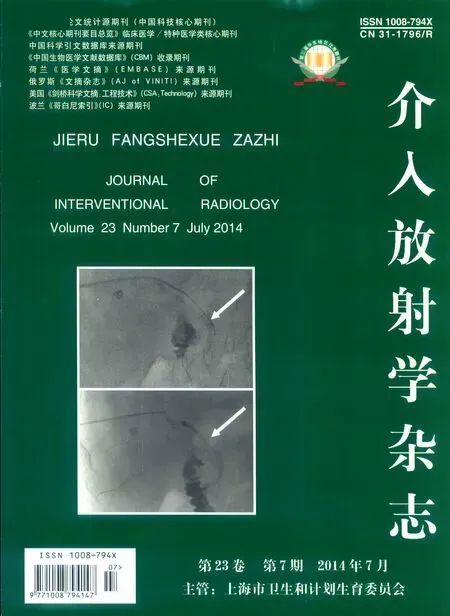TIPS术中引导门静脉分支穿刺方法
汤善宏,秦建平,束庆飞,蒋明德
TIPS术中引导门静脉分支穿刺方法
汤善宏,秦建平,束庆飞,蒋明德
·综述General review·
经颈静脉肝内门体分流术(TIPS)的完成涉及两个关键步骤:门静脉分支的穿刺和穿刺点安全性判断,其中穿中门静脉分支是手术成功的前提,也是TIPS操作中的关键环节。为了能准确、安全穿刺门静脉分支,目前有若干引导门静脉分支穿刺方法报道,如术中各种途径的间接门静脉造影、磁共振(MR)或CT及超声的实时引导等,本文将对这些引导门静脉分支穿刺方法做综述。
TIPS;门静脉分支穿刺;显影;研究进展
经颈静脉肝内门体分流术(TIPS)是治疗肝硬化门静脉高压导致顽固性腹水、消化道出血等并发症微创介入技术。其基本原理是用Seldinger技术穿刺颈静脉,建立颈静脉-上腔静脉-右心房-下腔静脉-右肝静脉通路,在右肝静脉或下腔静脉肝段与门静脉分支间建立门-体分流的人工通道,从而降低门静脉压力达到治疗的作用。该技术的关键步骤在于穿中门静脉的分支。要求术者对患者肝-门静脉的解剖有充分的了解,为了提高门静脉分支穿刺的准确性,临床上有多种引导穿刺的方法。本文将对各种引导门静脉分支穿刺的方法作一综述。
1 间接门静脉显影
门静脉系统相对独立,其周围均为细小的静脉,不能通过穿刺外周血管直接到达门静脉。只能通过与门静脉相关的血管如肠系膜上动脉、肝静脉等造影使门静脉间接显影,了解门静脉的状况,指导术中门静脉分支穿刺,这是目前应用最广泛的方法。间接门静脉造影,需穿刺动脉及增加对比剂用量,增加术中并发症发生的风险及射线曝露量。
1.1 经动脉间接门静脉造影
该方法是通过穿刺股动脉,将导管插入肠系膜上动脉或脾动脉(少数在肠系膜下动脉或胃左动脉),DSA下行间接门静脉造影。该方法目前应用最为广泛[1-4]。
1.2 楔形肝静脉造影
早在1994年,Rees等[5]介绍一种应用5 F端孔导管,其远端置于肝静脉末梢楔入注入CO2作为对比剂来进行间接门静脉造影的方法;Sheppard等[6]对CO2与含碘对比剂肝静脉楔入法造影对门静脉显影能力的比较,结果显示,应用CO2患者门静脉很快显影,显影质量优于含碘对比剂,因此该研究小组将此方法作为做常用的门静脉显影方法。此后,该法为多家采用,效果良好[7-9]。CO2作为对比剂有低剂量、避免过敏性休克、低肾毒性,在血管内滞留时间相对较长等优点,该方法操作时无需球囊闭塞导管,使操作简单,花费减少,也不会对肝脏组织染色而影响判断,对肝脏损失较小,有报道显示单独使用CO2即可指导完成TIPS复杂的操作。但CO2作为显影对比剂也有如下缺点:其显影分辨率较碘剂低,其低黏度导致其寻求低阻力回流路径,主要向肝静脉及侧支门静脉扩散,而不是向门静脉主干道扩散,影响其对门静脉及主干道显影。
2 其他造影及引导方法
2.1 肝动脉造影定位
门静脉分支,左右肝动脉及肝内胆管三者在肝内相伴而行,因此选择肝动脉某点也能间接反映门静脉分支的位置。早在1993年,Teitelbaum等[10]报道通过在右肝动脉远端导入末梢不透X线的标志,作为引导门静脉右支穿刺的参考。其后,该法又有多人沿用[11-13]。
2.2 直接门静脉造影
美国西北大学Wenz等[14]报道1例通过颈静脉路径TIPS手术失败病例,在复查腹部超声时发现脐周围区域2~3mm皮下静脉,并向上腹部肝脏回流,因此推测其可能是脐旁门体侧支静脉,在脐周局部小切口暴露该血管,超声引导下穿刺成功导丝进入门静脉左支造影,同时结合经颈静脉到右肝静脉,顺利完成TIPS。Chin等[15]报道在2002至2008年中,在该中心完成114例TIPS手术,通过评估脐周静脉与门静脉左支连接状况,选择其中22例患者在超声引导下通过脐旁静脉行门静脉造影,其中14例成功指导门静脉穿刺,其余8例因静脉直径太小(<0.3 cm)、结构紊乱或远端血栓形成失败。另外还有经皮经肝或脾穿刺门静脉系统对其造影是另一种方法[16]。韩国宏等[17]报道1例因门静脉血栓形成导致经肠系膜上动脉间接造影失败,采用经皮脾穿刺脾门部脾静脉成功实施分流手术。
3 超声导引
目前,已报道通过超声指导门静脉穿刺的方法有:血管内超声介入、经皮肝穿刺及消化道超声内镜3种。Petersen等[18]首先应用猪为动物模型,经股静脉穿刺将超声探头送入下腔静脉,经实时超声指导下从下腔静脉向门静脉穿刺,该实验在5头猪上均取得成功;随后该研究小组应用血管内超声来指导门静脉显影定位,31例患者术前接受腹部CT扫描来确定门静脉位置及大小,所有患者均穿刺成功[19]。多位学者应用下腔静脉血管超声来指导门静脉穿刺同样取得成功[20-21]。Buscaglia等[22]应用消化道超声内镜,通过食管进入胃,用7.5 MHz超声来分辨肝实质、肝动脉、腹腔干及分支、下腔静脉、肝静脉及门静脉,在动物身上成功完成门体分流术。Raza等[23]报道在超声引导下,经皮肝穿刺,找到肝静脉后超声引导门静脉穿刺进行门体分流,该方法对于肝静脉及门静脉解剖结构较为正常患者比较合适,而对于肝静脉及门静脉病变患者不适合。
4 MR或CT成像
Arepally等[24]构建血管内针形MR系统,在实验猪上通过实时MR显像肠系膜上下静脉及门静脉,结合放射透视造影对门静脉进行定位,指导门静脉的穿刺,10头猪实验均取得成功。该中心构建核磁与放射装置,将放射装置安装在2个电子回旋加速器之间,平板探头放置在与X射线相匹配架子下面,以方便MR与X射线交替操作而不需要移动患者。利用该设备及方法,TIPS手术在14例患者手术中13例取得成功[25]。MR是无创、零射线的显影方法,对组织成像较好,对流动的血液成像较敏感,MRI成像为复杂TIPS手术提供方便,但MR对于门脉成像存在以下缺点:患者呼吸会导致假像,肝实质损害也会导致显像质量欠佳,且图片显示及采集过程较为复杂、时间较长;手术过程中导管、导丝及支架等无法准确显影等因素限制了其应用。Fontaine等[26]报道应用术中CT显影进行指导肝、门静脉定位并引导TIPS穿刺,1992年至1996年,该研究小组应用该方法完成了150例TIPS手术,其中只有2例需要额外注射对比剂进行门静脉显影,其余患者术中CT均对门静脉成功定位,手术成功率100%[27]。但由于这种方法需要特定的设备,花费较高,这种方法应用也受到一定限制。
5 肝脏增强CT及肝-门静脉系统血管三维重建
我中心从2003年开始开展TIPS手术,最初2年采用传统双介入方法进行[28],2005年起采用术前肝脏增强CT及肝-门静脉系统血管三维重建来指导TIPS术中门静脉分支穿刺,取得了满意的临床效果。术前通过认真分析患者肝脏的增强CT及肝-门静脉血管三维重建影像,详细了解右肝静脉与门静脉分支间的空间解剖关系,确定穿刺出发点和门静脉分支穿刺靶点的位置。这种方法对门静脉系统解剖结构显影清楚,能较准确判断穿刺2点的空间关系。根据我们的经验绝大多数患者从肝静脉向门静脉穿刺只需1~2针即可完成,节约手术时间,也减少术中间接门静脉造影给患者带来额外的创伤及风险,减少射线摄入量。该方法也有一定局限性,由于不是术中实时显影,可能存在一些变化会影响术者对门静脉位置的判断,但目前为止尚未遇这种异常情况发生。目前这种方法已在西南局部地区推广应用。
以上述及的各种方法均有自身的优势及局限性,临床上应根据患者的实际情况和设备状况来选择合适的引导门静脉分支穿刺的方式。随着研究深入,辅助成像技术提高、以及施术者经验的不断积累,TIPS手术成功率会愈来愈高,为更多的肝硬化门静脉高压患者带来福音。
[1]Han G,Qi X,He C,et al.Transjugular intrahepatic portosystemic shunt for portal vein thrombosis with symptomatic portal hypertension in liver cirrhosis[J].JHepatol,2011,54:78-88.
[2]Qi X,Han G,Yin Z,et al.Transjugular intrahepatic portosystemic shunt for portal cavernoma with symptomatic portal hypertension in non-cirrhotic patients[J].Dig Dis Sci,2012,57:1072-1082.
[3]丁鹏绪,张文广,韩新巍,等.改良式TIPS治疗肝静脉广泛阻塞型布-加综合征的近期疗效[J].介入放射学杂志,2011,20:138-141.
[4]朱文科,单鸿,朱康顺,等.经颈静脉肝内门体分流术治疗顽固性腹水[J].介入放射学杂志,2004,13:11-14.
[5]Rees CR,Niblett RL,Lee SP,et al.Use of Carbon dioxide as a contrastmedium for transjugular intrahepatic portosystemic shunt procedures[J].JVasc Interv Radiol,1994,5:383-386.
[6]Sheppard DG,Moss J,Miller M.Imaging of the portal vein during transjugular intrahepatic portosystemic shunt procedures:a comparison of Carbon dioxide and iodinated contrast[J].Clin Radiol,1998,53:448-450.
[7]Yang L,Bettmann M.Identification of the portal vein:wedge hepatic venography with CO2or iodinated contrast medium[J]. Acad Radiol,1999,6:89-93.
[8]杨立,Bettmann M.CO2与含碘液性造影剂行肝静脉楔入法造影显示门静脉的能力[J].中华放射学杂志,1998,32:670.
[9]Maleux G,Nevens F,Heye S,etal.The use of Carbon dioxide wedged hepatic venography to identify the portal vein:comparison with direct catheter portography with iodinated contrast medium and analysis of predictive factors influencing levelofopacification[J].JVasc Interv Radiol,2006,17:1771-1779.
[10]Teitelbaum GP,Van Allan RJ,Reed RA,et al.Portal venous branch targeting with a platinum-tipped wire to facilitate transjugular intrahepatic portosystemic shunt(TIPS)procedures[J].Cardiovasc Intervent Radiol,1993,16:198-200.
[11]Warner DL,Owens CA,Hibbeln JF,et al.Indirect localization of the portal vein during a transjugular intrahepatic portosystemic shunt procedure:placement of a radiopaque marker in the hepatic artery[J].JVasc Interv Radiol,1995,6:87-89.
[12]MatsuiO,Kadoya M,Yoshikawa J,et al.A new coaxial needle system,hepatic artery targeting wire,and biplane fluoroscopy to increase safety and efficacy of TIPS[J].Cardiovasc Intervent Radiol,1994,17:343-346.
[13]Yamagami T,Tanaka O,Yoshimatsu R,et al.Hepatic arterytargeting guidewire technique during transjugular intrahepatic portosystemic shunt[J].Br JRadiol,2011,84:315-318.
[14]Wenz F,Nemcek AA,Tischler HA,et al.US-guided paraumbilical vein puncture:an adjunct to transjugular intrahepatic portosystemic shunt(TIPS)placement[J].JVasc Interv Radiol,1992,3:549-551.
[15]Chin MS,Stavas JM,Burke CT,et al.Direct puncture of the recanalized paraumbilical vein for portal vein targeting during transjugular intrahepatic portosystemic shunt procedures:assessment of technical success and safety[J].J Vasc Interv Radiol,2010,21:671-676.
[16]Haskal ZJ,Duszak R,Furth EE.Transjugular intrahepatic transcaval portosystemic shunt:the gun-sight approach[J].J Vasc Interv Radiol,1996,7:139-142.
[17]韩国宏,孟祥杰,殷占新,等.经皮脾静脉途径联合TIPS治疗伴海绵样变性的门静脉血栓[J].介入放射学杂志,2009,18:177-181.
[18]Petersen B,Uchida BT,Timmermans H,etal.Intravascular US-guided direct intrahepatic portacaval shunt with a PTFE-covered stent-graft:feasibility study in swine and initial clinical results[J].JVasc Interv Radiol,2001,12:475-486.
[19]Petersen B.Intravascular ultrasound-guided direct intrahepatic portacaval shunt:description of technique and technical refinements[J].JVasc Interv Radiol,2003,14:21-32.
[20]Petersen B,Binkert C.Intravascular ultrasound-guided direct intrahepatic portacaval shunt:midterm follow-up[J].J Vasc Interv Radiol,2004,15:927-938.
[21]Farsad K,Fuss C,Kolbeck KJ,et al.Transjugular intrahepatic portosystemic shunt creation using intravascular ultrasound guidance[J].JVasc Interv Radiol,2012,23:1594-1602.
[22]Buscaglia JM,Dray X,Shin EJ,et al.A new alternative for a transjugular intrahepatic portosystemic shunt:EUS-guided creation of an intrahepatic portosystemic shunt(with video)[J]. Gastrointest Endosc,2009,69:941-947.
[23]Raza SA,Walser E,Hernandez A,et al.Transhepatic puncture of portal and hepatic veins for TIPS using a single-needle pass under sonographic guidance[J].AJR,2006,187:W 87-W91.
[24]Arepally A,Karmarkar PV,Qian D,et al.Evaluation of Mr/ fluoroscopy-guided portosystemic shunt creation in a swine model[J].JVasc Interv Radiol,2006,17:1165-1173.
[25]Kee ST,Ganguly A,Daniel BL,et al.MR-guided transjugular intrahepatic portosystemic shunt creation with use of a hybrid radiography/Mr system[J].JVasc Interv Radiol,2005,16:227-234.
[26]Rossle M.Puncture of the portal bifurcation:a fatal comp lication of TIPS[J].Radiographics,1993,13:1184.
[27]Khabiri H,Fontaine A,Stockum A,et al.CT-guided localization of the portal vein before creation of a transjugular intrahepatic portosystemic shunt[J].AJR,1994,163:746-747.
[28]秦建平,蒋明德,徐辉,等.双介入治疗肝硬化门脉高压和脾功能亢进症[J].胃肠病学和肝病学杂志,2008,17:145-147.
The imaging guidance for the portal vein branch puncturing in perform ing TIPS:recen t progress in research
TANG Shan-hong,QIN Jian-ping,SHU Qing-fei,JIANG Ming-de.Department of Gastroenterology,General Hospital of Chengdu Military Region,Chengdu,Sichuan Province 610083,China
QIN Jian-ping,E-mail:jpqqing@163.com
The performance of transjugular intrahepatic portosystemic shunt(TIPS)has two key procedures:(1)portal vein branch puncturing,and(2)the correct judgment of the safety of the puncture site.The portal vein branch puncturing is the most important and difficult step for a successful TIPS procedure.Therefore,to find and to establish an proper access to the portal vein is critical.Nowadays,in clinical practice several imaging techniques have been used to localize the portal vein,such as magnetic resonance imaging,sonography,fluoroscopy,arteriography and computed tomography.This article aims to make a general review on these invasive and non-invasive localization techniques when a successful performance of TIPS is expected.(JIntervent Radiol,2014,23:640-643)
transjugular intrahepatic portosystemic shunt;portal vein branch puncture;visualization;progress in research
R735.3
A
1008-794X(2014)-07-0640-04
2013-10-24)
(本文编辑:俞瑞纲)
10.3969/j.issn.1008-794X.2014.07.022
成都军区总医院院管课题渊2013YG-B009冤
610083成都成都军区总医院消化内科(汤善宏、秦建平、蒋明德);拉萨77626部队医院(束庆飞)
秦建平E-mail:jpqqing@163.com

